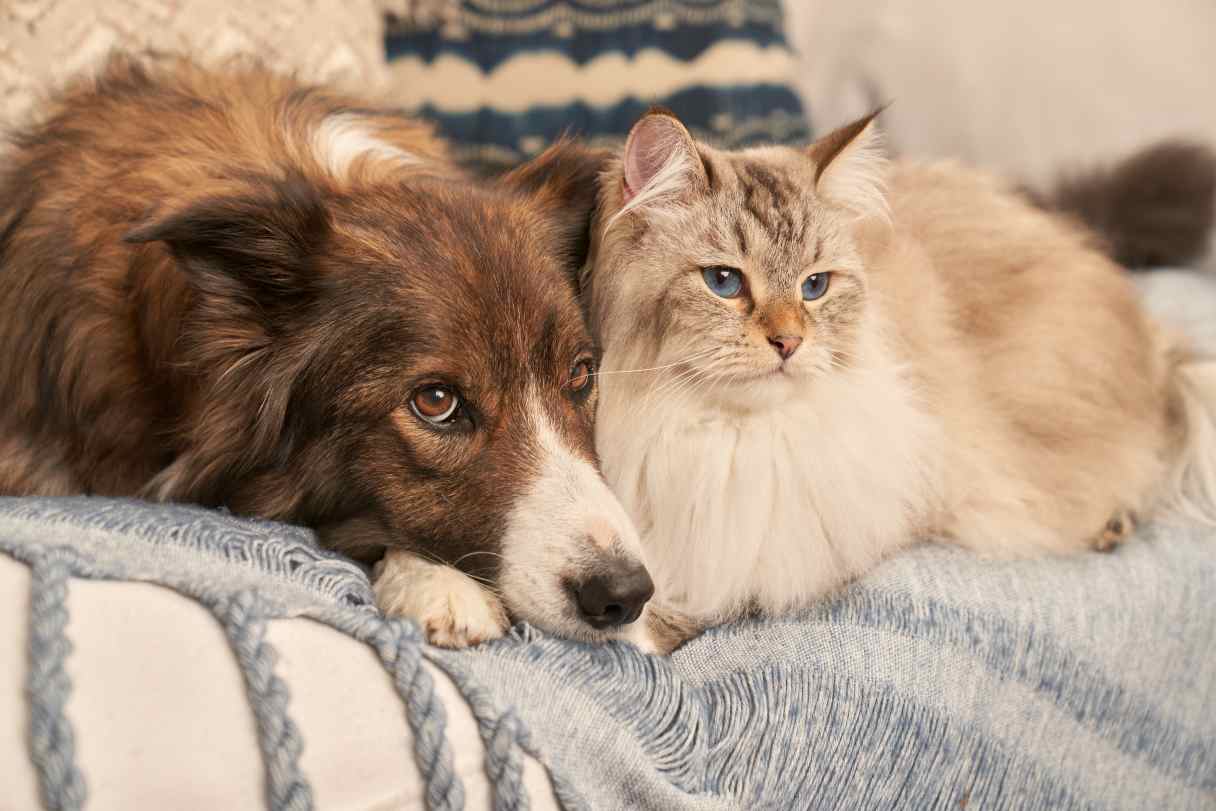Veterinary visits can be an unfamiliar and overwhelming experience for pets, filled with new sights, sounds and smells. Fear Free® veterinary care is designed to reduce stress and make these visits more comfortable for both pets and their people. By using calming techniques, gentle handling and positive reinforcement, veterinary teams help animals feel more at ease during exams and procedures.
Here’s how clinics are creating low-stress environments and how you can help prepare your pet for a successful visit.
What Is Fear Free Veterinary Care?
Fear Free veterinary care acknowledges that many aspects of a typical vet visit can cause fear, anxiety and stress (FAS) for pets. By considering veterinary care from a pet’s perspective, Fear Free strives to remove or minimize fearful aspects of vet visits so pets can receive care without stress and anxiety.
Fear Free courses are developed by experts in animal behavior, including veterinary behaviorists, internal medicine specialists, veterinarians, veterinary technicians, shelter professionals, animal trainers and groomers.
Overall, Fear Free methods focus on the pet’s emotional well-being, in addition to their physical health, during veterinary visits and other aspects of their routine care.
History
Fear Free was started in 2016 by Dr. Marty Becker with the goal of reducing the FAS that pets experience during veterinary visits. It has since grown into an organization that provides educational courses to veterinary professionals, pet professionals, animal welfare organizations and pet owners to help them understand FAS and minimize its impact during a pet’s everyday life.
Fear Free certification
Veterinary team members and clinics can become Fear Free Certified®. This means that individual staff members, or the entire veterinary team, have taken Fear Free courses to obtain certification.
Other pet care professionals, such as groomers and shelters, can also become Fear Free Certified. Using these facilities ensures the people working with your pet will consider their emotional well-being during all aspects of their care. To find a Fear Free Certified veterinarian near you, use the Fear Free Directory.
How Vet Visits Can Make Your Pet Anxious
Many aspects of a veterinary visit can trigger FAS in pets, including:
- Carrier. A pet’s stress often begins well before the visit starts. If a pet is not used to spending time in a carrier or wearing a seatbelt, restraint for a safe trip to the vet can cause anxiety.
- New place and people. Unless pets visit the veterinary hospital frequently, they may view it as a strange place where they are expected to endure handling by unfamiliar people.
- Other animals. Cats, in particular, can become stressed by seeing, hearing or smelling other, often larger animals.
- Past bad experiences. Pets may have memories of previous visits that include uncomfortable or painful procedures.
- Travel. Many pets ride in a car only when they go to the vet. A lack of familiarity with traveling, paired with a possibly unpleasant previous experience at the veterinary office, can cause pets to become anxious during car rides.
Visit-related stress has many negative consequences for pets, which may include:
- Altered vital signs — such as an increased heart rate and respiratory rate — that can interfere with an accurate diagnosis
- Defensive or aggressive behavior, possibly leading to injury to the pet, owner or veterinary staff
- Increasing fear of new people and places
- Missed veterinary visits
- Poor emotional well-being
Chronic stress can also lead to long-term health problems for pets, making Fear Free methods an essential aspect of a pet’s comprehensive healthcare.
Fear Free Methods That Benefit Pets
Veterinary teams that incorporate Fear Free care take measures to make each visit as pleasant as possible for pets. This may include techniques such as:
- Calming music and colors. Clinics often use soft colors and play calming music for pets to help set the tone for the visit.
- Comfortable exam tables. Hard, cold exam tables can cause anxiety, so soft mats or towels can be used to cover the surface.
- Considerate approach. Instead of immediately applying restraint, Fear Free techniques involve using gentle control to safely and comfortably position pets for veterinary care.
- Happy visits. Clinics often encourage pet owners to stop by with their pet for a short visit where the pet receives treats and attention without restraint or prodding.
- High-value treats. Treats are used liberally to reward pets for allowing handling and to help them form positive associations with veterinary visits.
- Non-slip floor coverings. Some dogs may become anxious about walking on slippery floors. Using rugs or mats can provide traction.
- Pheromone use. Diffusers and sprays with calming pheromones, such as Feliway® for cats and Adaptil® for dogs, are often used to send chemical messages that help pets relax.
- Sedation. Instead of forcing pets to undergo uncomfortable or stressful procedures, sedation may be used to help them relax. If a pet becomes stressed during a visit, the veterinary team will often stop and reschedule the visit for another day, using sedation.
- Separate waiting areas for cats and dogs. Cats can become anxious when they see or sense dogs nearby, and having their own waiting area can help prevent fear and anxiety.
- Touch gradient. Some pets may become anxious about having certain areas of their body handled, so veterinary teams start by touching areas the pet is comfortable with and slowly working their way toward the “off-limits” zones, while continuously evaluating the pet’s acceptance.
By using these techniques to make veterinary visits less stressful for pets, veterinary teams can help pets receive the care they need. Pets may be more cooperative for diagnostic testing and procedures, and pet owners may be less likely to skip visits if they aren’t stressful for them and their pet.
Tips to Help Your Pet Prepare for a Vet Visit
A Fear Free experience starts before a pet arrives at the veterinary clinic. You can help set the stage for a successful visit with these tips:
- Acclimate your pet to car rides. Take frequent, short trips with your pet so they become used to riding in the car.
- Bring your pet’s favorite treats. Although most clinics keep treats on hand, taking your pet’s favorite, familiar treats can help encourage their participation.
- Help your pet learn to like their carrier. Instead of only using the carrier for vet visits, leave the carrier out so your pet can become familiar with it. Place blankets and treats inside to encourage your pet to go in and out freely.
- Remain calm. Your pet reacts to your energy and can sense if you are anxious. By staying calm, you can help them realize that vet visits aren’t scary.
- Ask your vet about Fear Free options. If your pet becomes anxious during vet visits, ask your vet about Fear Free options, including pre-visit sedation. If your veterinary clinic doesn’t incorporate Fear Free methods, consider looking for a vet who does.
Taking the Fear out of Veterinary Care
While it might not be possible to make every aspect of your pet’s veterinary care completely stress-free, Fear Free methods can make each visit more pleasant for everyone involved. From creating a calming environment to approaching your pet slowly, Fear Free Certified veterinary professionals can help pets receive essential medical care. For uncomfortable or stressful procedures, Fear Free methods can include sedation to ensure a low-stress experience.
CareCredit Credit Card Financing for Pets
Taking good care of your pet’s well-being from nose to tail is essential. Make sure to stay up to date on their regular checkups at the vet to help keep your pet happy and healthy for a lifetime of love. You can use your CareCredit credit card for pet care throughout the year for routine veterinary services as well as emergencies and surgeries.* Use our Acceptance Locator to find a veterinarian near you that accepts CareCredit.
CareCredit is there for you and your pet every step of the way; continue your wellness journey by downloading the CareCredit Mobile App to manage your account, find a provider on the go and easily access the Well U blog for more great articles, podcasts and videos.
In addition to pet care, you can also use your CareCredit credit card for dentistry, cosmetic, vision, hearing, health systems, dermatology, pharmacy purchases, spa treatments and so much more within the CareCredit network. How will you invest in your health and wellness next?
Author Bio
Angela Beal, D.V.M., has more than 20 years of experience as a veterinarian. Leveraging her background in private practice and academia, she uses her passion for writing to convey information to pet owners to help them keep their pets healthy and happy.







